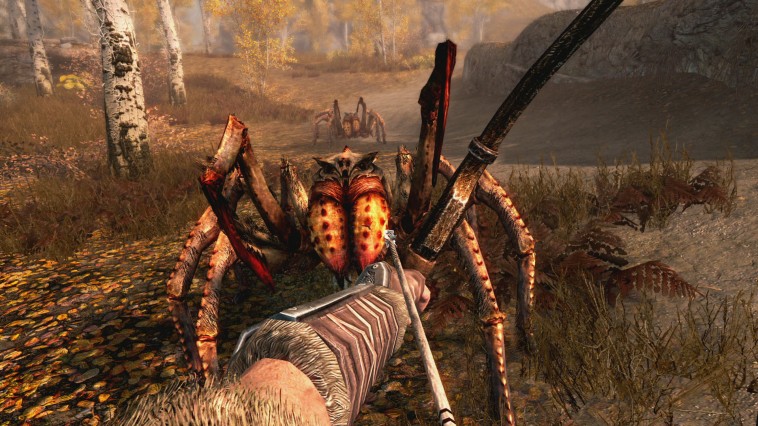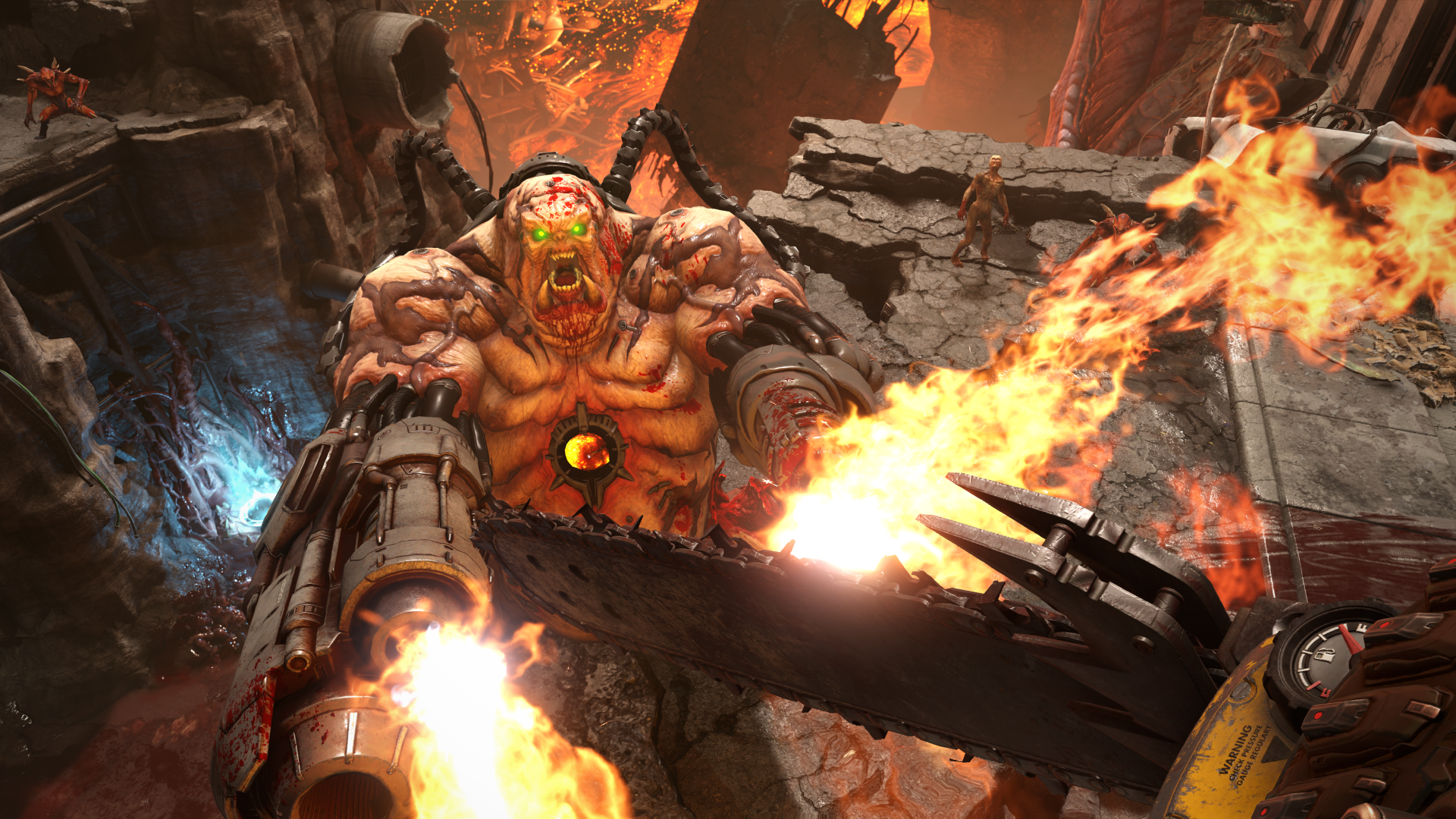How Doom changed PC gaming forever
The archetype of the modern shooter continues to influence all, a quarter of a century later

It’s been so long since Doom first slipped into floppy disk drives the world over that there’s an entire generation of console and PC players out there who’ve never even heard of Doom, let alone played it.
And yet, despite its age, this dusty old relic lives on every shooter that’s come and gone since. Every single First Person Shooter that’s taken over the world – or failed miserably – can doff its cap to Id Software’s seminal piece of software.
Not many games can call themselves genuine milestones, but Doom can claim such a title with confidence. For TechRadar's PC Gaming Week 2019, we look at how Doom helped change PC gaming forever.

Bloody blueprint
There are just so many elements that programmers John Romero and John Carmack helped popularize back in 1993 – concepts that laid out a fundamental blueprint not just for shooters, but for western videogames as a whole in the decades that followed.
The use of immersive 3D graphics at a time where games were still resigned to flat 2D sprites in 16-bits. It helped set the groundwork for networked multiplayer matches. It promoted the use of mods (or ‘WADs’ as they were known back then). Even how it deftly juggled everything from realistic gun physics to intricate level design. There’s a reason why plenty of games that came after were called ‘Doom clones’.
Doom was a breath of fresh air in so many ways. Rather than burying the player in needless narrative and the crushing presence of lore, Id Software let the levels themselves tell the story for it.
The sharp corners and constrictive corridors that exploded out into open arenas. Secret rooms full of treasure and death. It was a nightmare and a playground all in one, offering a stark alternative to the repetitive tunnels of, say, Wolfenstein 3D.
Sign up for breaking news, reviews, opinion, top tech deals, and more.
From the use of disorientating ways teleports would whisk you to a new part of the map, or how some chambers would be near pitch black while others were bright with daylight. It featured a labyrinthine approach that fostered a sense of chaos, long before the randomised concept of procedural generation.
But by learning where every turn would take you, where every secret was hidden and where every shotgun could be found, Doom empowered you in a way few other games did at the time.

History of violence
Of course, when you’ve created your own gaming subculture and established a flashpoint in the development scene, you’re always going to get copycats. However, among all those forgettable instalments you could finally see developers taking the principles Doom set in place and taking them one step further.
Marathon, for example – which arrived a good year later in 1994 – made a far smoother and more user–friendly take on networked multiplayer (a concept which Bungie would take countless steps further with Halo: Combat Evolved seven years later). It would take another five years for deathmatches to fund their feet online in 1999, but Doom’s influence was already spreading its roots.
In the same year, System Shock – the precursor to BioShock and its own gaggle of copycats – also dropped, and it too took considerable inspiration from Id’s seminal corridor shooter.
It took the sense of dread Doom had captured so well and made you even more vulnerable, placing more emphasis on puzzle solving and storyline. The result was a game that was well ahead of its time in the early ’90s, especially in regards to its 3D visuals and physics engine.
Right away, the formula of Doom’s DNA continued to thrive in the burgeoning ‘corridor shooter’ scene. Who would have thought it would be this genre that would help rejuvenate the Star Wars licence? Not only that, but those core tenants would evolve as a result. So, when LucasArts unleashed Star Wars: Dark Forces it presented a considerable step forwards for the genre.

Previously, shooters had mostly stuck to using an X–Y axis for movement (where you could look left and right, but not up or down). Thanks in part to the in-house Jedi engine, players in Dark Forces could look around in true 3D fashion, which – when coupled with the game’s innovative use of multi-tiered levels – created one of the most immersive shooters yet.
In the three years after Doom’s first release in December 1993, 3D graphics evolved in leaps and bounds, and studios began finding new ways to innovate in terms of both aesthetics and programming ideas. Duke Nukem 3D was less of trendsetter and more of a pastiche, but it still took countless features from Doom and riffed on them.
Levels were filled with secret rooms and shortcuts, weapons were over-the-top in their sheer violence and no one had managed to make a shooter quite as humorous as one starring the titular Duke. It was satire, but Doom’s legacy was there for all to see.
In the same year, Bethesda Softworks unleashed The Elder Scrolls II: Daggerfall on the world, finally freeing the corridor shooter from its traditional linear environments.
Embracing more of a traditional RPG setup, Daggerfall was a revelation in its approach to ‘open–world’ level design (an entirely new term at the time) and grander storytelling.
In all honesty, it was a world away from the flat The Elder Scrolls Arena in 1994, but even as an antithesis to the speed and mechanical purity of Doom (especially with its heavy focus on story and world-building), it still owed much to Doom’s pioneering presence.

Mod scene
Of course, another big game launched in 1996, and it just happened to be from the makers of Doom itself. Quake was a giant leap forwards in every way for the genre, taking countless elements that made Doom so quintessentially addictive and making it even more irresistible.
While Doom employed the use of flat sprites in a 3D environment, Quake’s new engine used fully-rendered 3D assets, and the difference was night and day. It made for more intricate levels, far more detailed enemies and set the stage for some of the decade’s best online multiplayer arenas, including the still-brilliant Quake 3 Arena.
By the late ‘90s, Doom’s popularity continued to grow, despite its age. Why? Because of how its developer had embraced the huge modding community. The programmers of tomorrow were building their own levels, playing with the game engine and finding new and ingenious ways to play online.
John Cormack even went as far as releasing the source code for Doom in 1997. This set a precedent for fan-made content and informed everything from the rise of Counter–Strike out of Half-Life and the sheer volume of mods for The Elder Scrolls V: Skyrim years later.

Just before the Millennium, the blueprint for networked multiplayer had evolved once more, as online matchmaking became an affordable and technically proficient means of connecting shooter fans.
Within the space of a month in 1999, the PC gaming community saw deathmatches taken to new heights with Quake 3 Arena and Unreal Tournament. Inspired by both the deep creativity of the modding community and the groundbreaking work of Id, these two games made online multiplayer fast, fun and endlessly replayable.
The advent of online multiplayer played right into one of Doom’s most misunderstood traits: that movement, momentum and positioning are far more important than firepower alone.

For the likes of Unreal Tournament and Quake 3 Arena, speed was everything. Jump pads, teleporters and collecting health/shield power–ups tapped directly into Doom’s focus on tactical movement. Doom was always about survival: learning to use every resource at your disposal to go from desperate survivor to untouchable god.

Doom eternal
Of course, in the modern era, shooters have taken on a very different guise, where various new systems and ideas and have long weighed the genre down. XP progression, crafting mechanics, over–the–top set–pieces and convoluted stories all convalesce to pull the genre in countless directions.
It’s a good thing in its own way, as games should always be moving forwards, and it’s the prerogative for developers to push the envelope, but it does make you long for a shooter that’s free from over–complication.
With only six weapons to its name, Doom didn’t need a Matrix–style rack of upgradeable weapons, skill–trees and myriad characters. It just needed a problem-solving mind and an itchy trigger finger. So it’s fitting that 26 years on, Doom feels more relevant than ever. There’s a purity to its simplicity. It can be an arcade blaster for some, but for others it’s a far more nuanced creature filled with strategies, secrets and more.
The 2016 reboot has retained some of that purity with its focus on unbridled creative violence and the strategy of momentum, movement and positioning – and its sequel, 2019’s Doom Eternal looks to continue that mantra – but even it has lost some of the magic that spartan early ’90s approach bestowed upon its predecessor.
Being a product of inferior technology and limited resources has resigned plenty of games to irrelevance as the medium continues to grow and change, but Doom’s characteristics have somehow defied age. Every pixel has its place, and every element has its purpose, even now.
- The best PC games 2019: the must-play titles you don’t want to miss
Welcome to TechRadar’s PC Gaming Week 2021, our celebration of the greatest gaming platform on Earth. Despite the global pandemic and ongoing GPU shortages, PC gaming has never been more vibrant and exciting, and throughout the week we’ll be reflecting this with a selection of in-depth articles, interviews and essential buying guides.